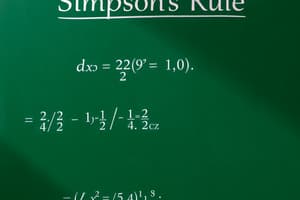Podcast
Questions and Answers
What key parameter must be consistent between ordinates when applying Simpson's First Rule?
What key parameter must be consistent between ordinates when applying Simpson's First Rule?
- The area function
- The height of ordinates
- Simpson's multipliers
- The common interval (h) (correct)
In Simpson's First Rule, what do the numbers 1, 4, and 1, used in the formula, represent?
In Simpson's First Rule, what do the numbers 1, 4, and 1, used in the formula, represent?
- Simpson's multipliers (correct)
- Ordinate lengths
- Areas of sections
- Common intervals
A steel plate section is divided into three ordinates for area calculation using Simpson's First Rule. If the ordinates measure 2m, 5m, and 2m respectively, and the common interval is 3m, what is the approximate area of the plate?
A steel plate section is divided into three ordinates for area calculation using Simpson's First Rule. If the ordinates measure 2m, 5m, and 2m respectively, and the common interval is 3m, what is the approximate area of the plate?
- 22 $m^2$
- 66 $m^2$
- 44 $m^2$
- 33 $m^2$ (correct)
When extending Simpson's First Rule to a shape with five ordinates, how can the total area be calculated?
When extending Simpson's First Rule to a shape with five ordinates, how can the total area be calculated?
A ship's water-plane area has half-ordinates spaced equally. Which rule is most appropriate for calculating the water-plane area if there are an odd number of ordinates?
A ship's water-plane area has half-ordinates spaced equally. Which rule is most appropriate for calculating the water-plane area if there are an odd number of ordinates?
A ship is floating in salt water with a known TPC. If the water-plane area (WPA) is 43.12 $m^2$ and the salt water relative density (RD) is 1.025, what is the TPC (tonnes per centimeter immersion)?
A ship is floating in salt water with a known TPC. If the water-plane area (WPA) is 43.12 $m^2$ and the salt water relative density (RD) is 1.025, what is the TPC (tonnes per centimeter immersion)?
What are the correct Simpson's multipliers for a shape divided into 7 ordinates when applying Simpson's First Rule?
What are the correct Simpson's multipliers for a shape divided into 7 ordinates when applying Simpson's First Rule?
Simpson's Second Rule is applied to a shape. What condition regarding the number of ordinates must be met to accurately apply this rule?
Simpson's Second Rule is applied to a shape. What condition regarding the number of ordinates must be met to accurately apply this rule?
What are the Simpson's multipliers according to Simpson's Second Rule for a shape with 4 ordinates?
What are the Simpson's multipliers according to Simpson's Second Rule for a shape with 4 ordinates?
A plate section is divided into 4 sections for area calculation using Simpson's Second Rule. If the ordinates measure 3m, 6m, 6m, and 3m respectively, and the common interval is 4m, what is the approximate area of the plate?
A plate section is divided into 4 sections for area calculation using Simpson's Second Rule. If the ordinates measure 3m, 6m, 6m, and 3m respectively, and the common interval is 4m, what is the approximate area of the plate?
A small boat's half water-plane area is divided into sections for area calculation using Simpson's Second Rule. The half-ordinates measure 0.20 m, 1.20 m, 1.70 m, 1.50 m. If the ordinates are equally spaced 2 m apart, what is the approximate half water-plane area?
A small boat's half water-plane area is divided into sections for area calculation using Simpson's Second Rule. The half-ordinates measure 0.20 m, 1.20 m, 1.70 m, 1.50 m. If the ordinates are equally spaced 2 m apart, what is the approximate half water-plane area?
What is the primary application of Simpson's rules in naval architecture, according to the provided material?
What is the primary application of Simpson's rules in naval architecture, according to the provided material?
In the context of ship stability, what does 'dynamical stability' refer to?
In the context of ship stability, what does 'dynamical stability' refer to?
What is the role of the 'curve of statical stability' (GZ curve) in assessing a ship's stability?
What is the role of the 'curve of statical stability' (GZ curve) in assessing a ship's stability?
What adjustment is suggested when 'dynamical stability' is being considered in relation to the GZ curve?
What adjustment is suggested when 'dynamical stability' is being considered in relation to the GZ curve?
Which of the following parameters does the calculation of righting moments directly incorporate?
Which of the following parameters does the calculation of righting moments directly incorporate?
For a ship design to comply with IMO's intact stability criteria, what is the key application of calculating area under the curves derived using Simpson's rules?
For a ship design to comply with IMO's intact stability criteria, what is the key application of calculating area under the curves derived using Simpson's rules?
When extending Simpson's First Rule to determine a half water-plane area, and the multipliers for the entire area are summed into a single shape, what considerations should be made at the boundary of both shapes?
When extending Simpson's First Rule to determine a half water-plane area, and the multipliers for the entire area are summed into a single shape, what considerations should be made at the boundary of both shapes?
Considering the flexibility in applying Simpson's rules, when might either Simpson's First or Second Rule be suitable for calculating area under a curve?
Considering the flexibility in applying Simpson's rules, when might either Simpson's First or Second Rule be suitable for calculating area under a curve?
Flashcards
Simpson's Rules
Simpson's Rules
A method to calculate areas under curves without integration.
Common Interval (h)
Common Interval (h)
The distance between ordinates in Simpson's rule.
Simpson's Multipliers
Simpson's Multipliers
Numerical factors applied to ordinates in Simpson's rules.
Simpson's Second Rule formula
Simpson's Second Rule formula
Signup and view all the flashcards
Dynamical Stability
Dynamical Stability
Signup and view all the flashcards
Study Notes
- Simpson's Rules provide a method for calculating areas under curves without complex integration techniques.
- These rules are used to calculate areas under the curve of static stability, ensuring a ship's loaded condition meets IMO stability standards.
Simpson's First Rule
- Simpson's First Rule applies to shapes defined by ordinates (A, B, C) with lengths in meters and equal spacing (h), known as the common interval.
- Formula for area calculation: AREA = (h/3) * (1A + 4B + 1C), where 1, 4, and 1 are Simpson's multipliers.
- Example: Calculating the area of a steel plate section involves applying the formula directly with given dimensions.
Extension of the First Rule
- When dealing with shapes having more than three ordinates (e.g., a ship's half water-plane area), divide the area into sections.
- Calculate each area separately using Simpson's First Rule.
- Sum the results to find the total area.
- An alternative method involves summing the Simpson's multipliers for ordinates forming the boundary of adjacent shapes and treating the entire shape as one.
- This method can be applied to shapes with 5, 7, 9 or more ordinates.
Simpson's Second Rule
- Simpson's Second Rule applies to shapes as shown in Figure 14.6.
- The formula is: AREA = (3h/8) * (1A + 3B + 3C + 1D).
- Simpson's multipliers for this rule are 1, 3, 3, and 1.
- This rule applies when the number of ordinates minus one is wholly divisible by three
- The formula is applied analogously as in the first rule, using the multipliers and distances.
Extension of the Second Rule
- For shapes with more than four ordinates, apply the same approach as extending the First Rule.
- Calculate the area by combining the multipliers.
- The multipliers for shapes with seven ordinates are 1, 3, 3, 2, 3, 3, 1.
'Odd Ordinate Rule'
- Note that Simpson's first rule can be used whenever there are an odd number of ordinates
- Simpson's multiplier for three ordinates are 141
- Simpson's multiplier for five ordinates are 14241
- Simpson's multiplier for seven ordinates are 1424241
- Simpson's multiplier for nine ordinates are 142424241
Alternate uses of Simpson's Second Rule
- Simpson's Second rule can be used when (number of ordinates -1) / 3 is a whole number
- Simpson's multiplier for four ordinates are 1331
- Simpson's multipliers for seven ordinates are 1332331
- Simpson's multipliers for ten ordinates are 1332332331
Dynamical Stability Definition
- Dynamical stability is defined as the work required by external forces (wind, waves) to incline a ship to a specific angle.
Studying That Suits You
Use AI to generate personalized quizzes and flashcards to suit your learning preferences.




